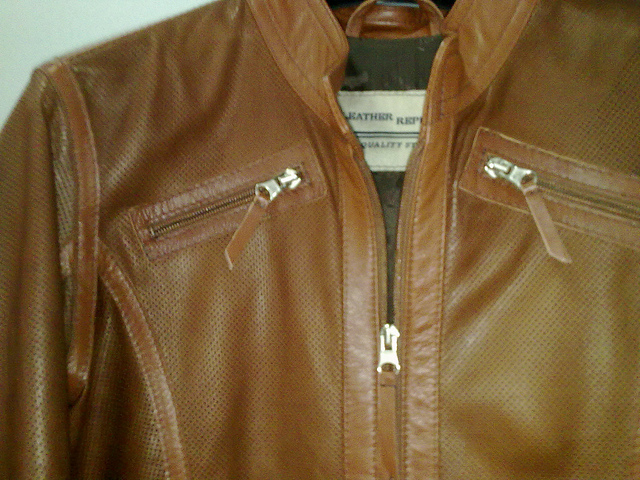Leathers jackets offer a unique style that’s simply not available in other forms of outwear. They posses the perfect combination of aesthetics and functionality, making them the preferred choice among many men and women. Leather jackets can be dressed up or dressed down, depending on the occasion and your preference. You can wear them when running errands around town, or you can wear them when attending a formal or semi-formal event. The same cannot be said for other jackets and coats, making leather jackets truly unique and one of a kind.
But there are ways to enhance the utility of a leather jacket even further, some of which we’re going to discuss in today’s blog post. So if you’re looking to maximize the utility of your leather jacket, keep reading for some essential tricks and hacks. While you may already know some of them, there are others that will probably surprise you.
Preserve the Color
Leather jackets, like all garments and accessories made of genuine leather, have a tendency to fade over time. While this typically doesn’t cause any direct damage, it can minimize the jacket’s luster and “glow.” The good news is that you can protect your leather jacket from this phenomenon by limiting its exposure to sunlight. Sunlight contains powerful ultraviolet (UV) rays that speed up the process of fading. Therefore, limiting your jacket’s exposure to sunlight will naturally preserve its color. This doesn’t necessarily mean that you should avoid wearing it outdoors on a sunny summer day, rather you should keep it stored in a closet where there’s little-to-no sunlight. This will go a long ways in protecting your leather jacket’s color from fading.
Make it Warmer
Want to make your leather jacket warmer? Granted, leather jackets are already incredibly warm thanks to the insulation they provide. When the fall and winter seasons roll around, you can rest assured knowing that it will keep you warm and comfortable. But if you’re looking for an even warmer leather jacket, you should make it quilted. Some stores, including LeatherCult, offer quilting on their leather jackets. Basically, quilting is the addition of extra fabric or material within the leather, improving its thermal insulation value even further. It’s a simple addition that can greatly enhance the warmth and thermal insulation of a leather jacket. Quilting material is typically cotton or wool, meaning it’s not going to add much weight to your jacket. On the contrary, it’s actually incredibly light and fluffy, offering warmth, softness and comfort.
Regulate the Humidity
We’ve talked about this before on our blog, but it’s worth mentioning again that leather jackets should be stored in a climate-controlled environment with a suitable humidity level. Humidity refers to the total amount of moisture vapor in the air. When there’s significant moisture vapor in the air, the air is humid. When there’s little-to-no moisture vapor in the air, the air is dry and not humid. So, how does this affect leather jackets? Well, leather jackets are constantly absorbing and releasing moisture vapor into the surrounding environment, depending on the relative humidity. When stored in a dry environment, a leather jacket may release most or all of its moisture vapor, which can subsequently cause it to dry out and even crack. When stored in a humid environment, the effects can be equally bad, as excess moisture will settle in the pores of leather, increasing the risk of mold and mildew.
So, what’s the right humidity level for storing a leather jacket? A good rule of thumb is to store leather in an environment with a relative humidity of 40-50%. This means the air is roughly half as saturated as it “can” be. Anything higher or lower than 40-50% relative humidity increases the risk of damage.
Protect Leather from Dirt and Debris
Depending on when and where you wear your leather jacket, it may accumulate dirt, dust and debris. This is particularly true when wearing a leather jacket outdoors (for obvious reasons). There’s a quick and easy way to keep your leather jacket clean, however: treat it with a leather protector spray product. Available for sale at most leather goods stores, this product is similar to Scotchgard, only for leather instead of furniture. Featuring an odorless, colorless combination of liquid chemicals and compounds, it’s sprayed directly on leather to create a barrier of protection between it and dirt. Keep in mind that leather protectant sprays such as this are not permanent and must be reapplied regularly for maximum results. As long you add a fresh coat once every couple of months, though, it will prove invaluable in keeping your leather jacket clean and free of dirt and debris.
Make Leather Jackets Soft with Conditioning Products
In addition to using a protectant spray on your leather jacket, you may also want to use a conditioning product. Leather conditioning products play an important role in keeping leather soft and supple. As stated above, leather releases moisture into the surrounding environment when exposed to dry air. This can subsequently result in a hard, stiff jacket that’s anything but comfortable to wear. A simple and effective way to protect your leather jacket from phenomenon is to apply a conditioning product to it on a regular basis. Leather conditioning products like Saddle Soap are intended to provide valuable moisture to leather, protecting it from drying out.
Prevent Wrinkles When Transporting
Here’s a scenario to consider: you’re headed off on vacation and want to bring your leather trip. The problem is that you have limited luggage space and don’t want to stuff your jacket inside, fearing it will create wrinkles and creases. A simple solution to this problem is to vacuum-seal your leather jacket. By vacuuming sealing your leather jacket, you’ll preserve its shape while protecting it from wrinkles. When you arrive at your destination, simply break into the vacuum-sealed bag and you’ll have a clean, crisp jacket that’s ready to be worn.


